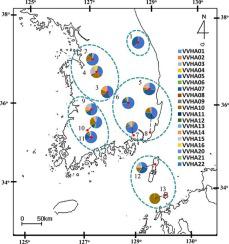Journal of Asia-Pacific Entomology ( IF 1.5 ) Pub Date : 2021-03-11 , DOI: 10.1016/j.aspen.2021.03.004 Jun Seong Jeong , Min Jee Kim , Jeong Sun Park , Keon Hee Lee , Yong Hun Jo , Jun-ichi Takahashi , Yong Soo Choi , Iksoo Kim

|
The yellow-legged hornet, Vespa velutina nigrithorax (Hymenoptera: Vespidae), invaded South Korea in 2003 through Busan metropolitan city, which is located in the southeast region of the country. Previous studies aiming to trace the origin of V. velutina in Korea used a portion of mitochondrial (mt) COI and detected a single haplotype common to the site of origin. However, no subsequent study on invasive dynamics such as additional entry and/or another site of entry has been performed. In this study, segments of mt COI, CytB, and lrRNA were sequenced from 238 individuals collected in 11 Korean and two Japanese localities, but no variation in each gene was observed. Thus, we developed two intergenic spacer (IGS) sequences from the publicly available mt genome of V. velutina, which provided substantially increased variability (i.e., 19 haplotypes with 1.74% maximum sequence divergence in 1,129–1,146-bp-long concatenated sequences). Population genetic analyses using the concatenated sequences unexpectedly provided higher genetic diversity estimates in the northwest and southwest regions, both of which also harbor international cargo ports, than in the southeast region, in which Busan is located. Furthermore, this genetic result was roughly concordant with our questionnaire survey demonstrating that V. velutina was observed in apiaries located in the northwest and southwest regions up to 2012, when there was no reported prevalent distribution of the hornet beyond the southeast region. These results collectively suggest that the northwest and southwest regions of Korea are additional sites of V. velutina entry to the country, independent from the southeast region origin.
中文翻译:

利用新发现的可变线粒体DNA序列,追踪黄脚大黄蜂大黄蜂(Vespa velutina nigrithorax(膜翅目:Vespidae))的入侵特征
黄腿大黄蜂Vespa velutina nigrithorax(膜翅目:Vespidae)于2003年通过位于该国东南部的釜山市入侵韩国。先前旨在追踪韩国V.velutina起源的研究使用了一部分线粒体(mt)COI,并检测到一个起源于该位点的单倍型。但是,尚未进行有关侵入性动力学(例如额外进入和/或另一个进入部位)的后续研究。在这项研究中,mt COI,CytB和lrRNA的片段分别从11个韩国地区和2个日本地区收集的238个人进行了测序,但未观察到每个基因的变异。因此,我们从V. velutina的mt基因组中开发了两个基因间隔区(IGS)序列,这些序列提供了显着提高的变异性(即19个单倍型,在1,129–1,146-bp长的串联序列中最大序列差异为1.74%)。使用串联序列进行的人口遗传学分析出乎意料地提供了西北和西南地区的遗传多样性估计,这两个地区也都设有国际货运港口,比釜山所在的东南地区更高。此外,这种遗传结果与我们的问卷调查大致吻合,证明了V. velutina直到2012年,在西北和西南地区的养蜂场中都观察到了这种现象,当时没有报道称大黄蜂在东南地区以外普遍分布。这些结果共同表明,朝鲜的西北和西南地区是独立于东南地区起源的V. velutina进入该国的其他地点。


























 京公网安备 11010802027423号
京公网安备 11010802027423号